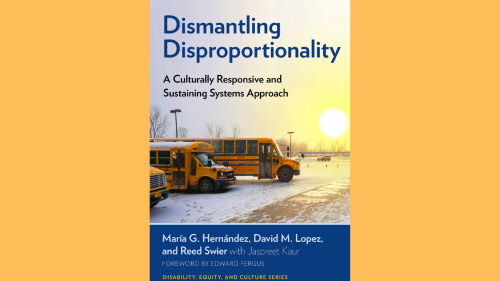By María G. Herńandez, David M. Lopez, and Reed Swier
“If your success is defined as being well adjusted to injustice and well adapted to indifference, then we don’t want successful leaders. We want great leaders who love the people enough and respect the people enough to be unbought, unbound, unafraid, and unintimidated to tell the truth.” – Dr. Cornel West
Dismantling Disproportionality is a book that emerged from a place of love and hope. Throughout several years of the authors partnering with school districts, we were inspired and transformed by numerous parents/caregivers, students, and educators we met. They were trailblazers, advocates, brave truth tellers, and leaders taking action to mitigate the harm being caused to children of color, multilingual students, students with disabilities, and those at the intersections of these and other marginalized identities.
As truth tellers ourselves, we were transparent with districts that educators cannot be culturally responsive to students, families, colleagues and communities of differences until they engage in the journey of personal, critical self-reflection. We were also honest with districts and schools that race based disproportionality requires the lift of engaging in truthful and difficult conversations that center how race and racism impact students, families and fellow educators.
Like other scholars (Kramarczuk Voulgarides, Fergus, & King Thorius, 2017; Kramarczuk Voulgarides, 2018; Sullivan & Osher, 2019; Kramarczuk Voulgarides et al., 2021), we position disproportionality as more than a special education issue but, rather, as a broader issue of educational inequality. Disproportionality in special education has always paralleled a persistent history of chronic socioeconomic and racial inequalities relating to the country’s history of denying educational opportunities to marginalized and minoritized students. We understand that disproportionality is not simply an outcome, instead disproportionality is about the overall experiences our children are having in educational settings–experiences that ultimately lead to these disparities.
This book draws on the authors’ experiences as technical assistance providers with the Center for Disproportionality, coupled with the latest research findings on the causes of racial disproportionality in general and special education. The four case study chapters underscore the diverse pathways in which school districts were engaged. Throughout these chapters, the authors examine critical components of addressing disproportionality such as leadership, district messaging, internal capacity building, and individual's and district’s overall commitment to dismantling disproportionality in education settings. The authors conclude that the most effective way to address disproportionality is to use a culturally responsive educational systems approach that critically engages practitioners at the intersection of beliefs, policies, procedures, and practices.
Regardless of the variation in the district’s student, staff and community demographics, the following always rang true:
- Equity is not possible without acknowledging and eradicating the bias based beliefs that lead to historically marginalized students-, particularly Black, Indigenous and Latinx-, being punished, excluded, and offered less humanity than their white peers.
- We do not get to equity without recognizing how bias based-beliefs such as deficit thinking bleeds into educational policies, procedures, and practices.
- And we do not get to equity by maintaining a color-evasive lens and failing to acknowledge, understand, and actively remedy how race and racism continually impact students and families of color within the walls of our school buildings.
We can consciously dismantle disproportionality when we ask critical questions and authorize ourselves to be brave and take action.
As highlighted by Dr. Pedro Noguera; “The message of this book is hopeful and inspiring. It shows us that by reflecting on our actions and holding ourselves accountable, educators can take action to make schools more just and equitable. Our children deserve nothing less.” Our hope is that as you read this book, you use it as a guide on how to tackle your community’s disproportionality; that you lean into the work as a messy journey, and not a linear ‘fix it’ moment. Most importantly, we hope you realize that once you are on the path of dismantling disproportionality, that it is possible. The promises and challenges we lay out may mirror what you see occurring in your district and school, and we want to encourage you to stay on the path. It is our deepest hope that this book will be a resource ‘when the rubber meets the road.’ This is the work!
As you and your learning community look to engage this work, we leave you with the following critical questions:
1) How will you hold safe space for colleagues, families, and students of color who have continually experienced and/or have advocated for disrupting disproportionality?
2) How will you hold a brave space for your white colleagues without centering their experiences while simultaneously addressing how their fragility and defensiveness may derail progress?
3) How will you determine the beliefs, policies, practices, and procedures contributing to your local disproportionality and what will you do to address it?
Dismantling Disproportionality: A Culturally Responsive and Sustaining Approach
Dismantling Disproportionality: A Culturally Responsive Approach is a new book written by a quartet of NYU Metro Center staffers and alum, including Dr. María G. Hernández, David M. Lopez, and Reed Swier, with Jaspreet Kaur. Their new book is currently available in paperback, hardcover, and ebook.
Learn more about the book here
References
Kramarczuk Voulgarides, C. K. (2018). Does compliance matter in special education?: IDEA
and the hidden inequities of practice. New York, NY: Teachers College Press.
Kramarczuk Voulgarides, C., Aylward, A., Tefera, A., Artiles, A. J., Alvarado, S. L., & Noguera,
P. (2021). Unpacking the logic of compliance in special Education: contextual influences on discipline racial disparities in suburban schools. Sociology of Education, 94(3), 208–226. http://doi.org/10.1177/00380407211013322
Kramarczuk Voulgarides, C., Fergus, E., & King Thorius, K. A. (2017). Pursuing equity:
Disproportionality in special education and the reframing of technical solutions to address systemic inequities. Review of Research in Education, 41(1), 61–87. https://doi.org/10.3102/0091732X16686947
Sullivan, A. L., & Osher, D. (2019). IDEA’s double bind: A synthesis of disproportionality
policy interpretations. Exceptional Children, 85(4), 395–412. https://doi.org/10.1177/0014402918818047
David M. Lopez, Senior Technical Assistance Specialist, with WestEd's Talent Development and Diversity team.



